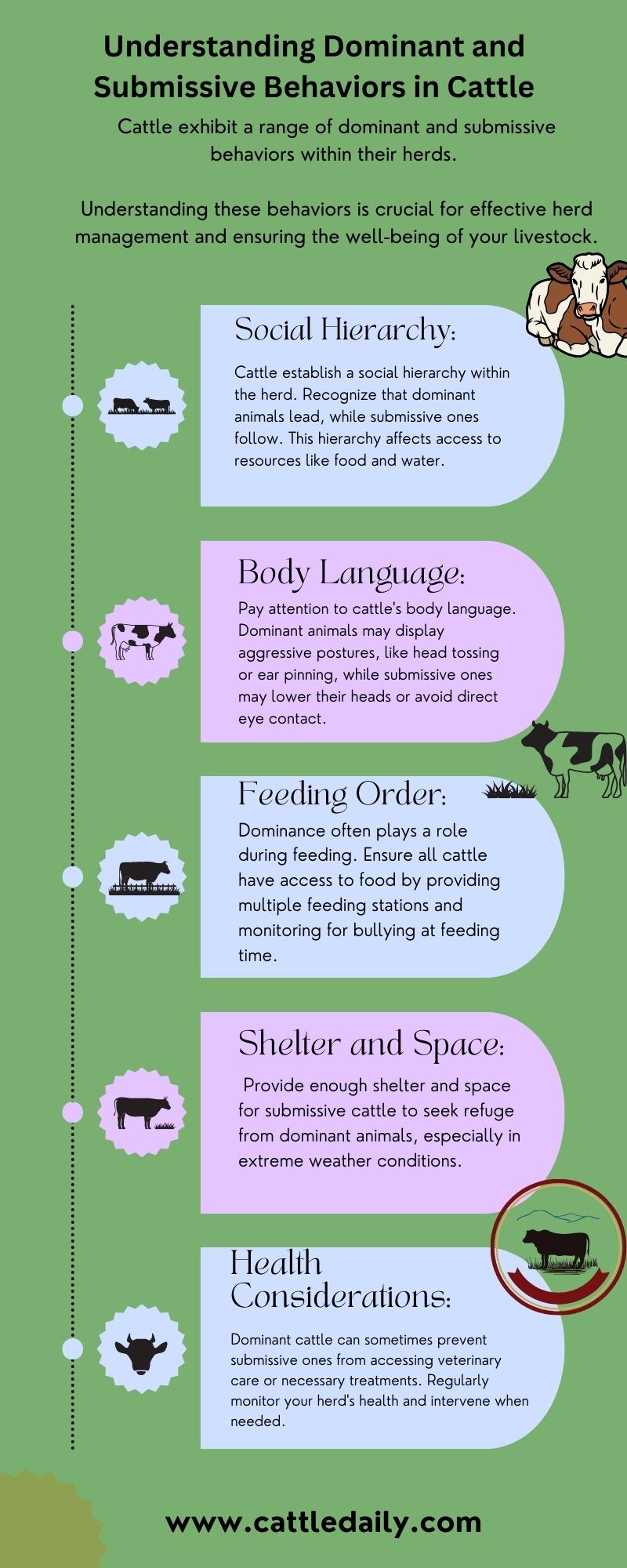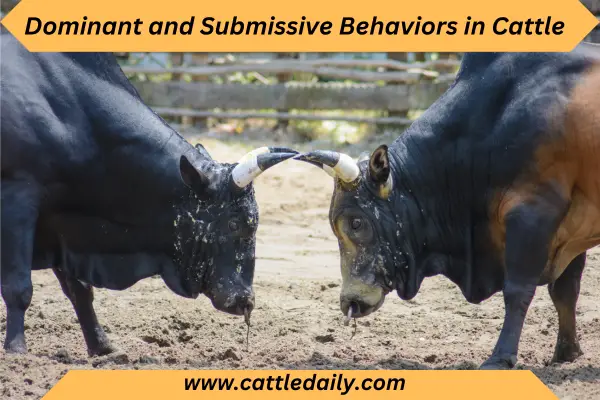Dominant and Submissive Behaviors in Cattle
Cattle are herd animals that establish complex social hierarchies within their groups. Understanding the dominant and submissive behaviors cattle exhibit can provide insight into herd dynamics and assist cattle owners in ensuring smooth operations.
In this blog article, we will discuss The importance of social hierarchy in cattle herds, Common dominant behaviors exhibited by cattle, Signs of submissive cattle and their role in the herd and tips for managing dominant and submissive cattle
The Social Structure of Cattle Herds
Cattle naturally form stratified social groups with defined roles and ranks. The herd hierarchy serves to maintain order, reduce conflict, and allow for cooperative behaviors like feeding and resting.
At the top of the hierarchy is the dominant boss cow who commands the most authority. Below the lead cow are subordinates who exhibit varying degrees of dominance and submissiveness. The herd queen is usually the oldest and most experienced female.
Knowing the unique social structure of cattle allows farmers to understand herd behaviors and interactions better. Monitoring positions in the hierarchy enables early intervention to prevent unwanted aggression or bullying.
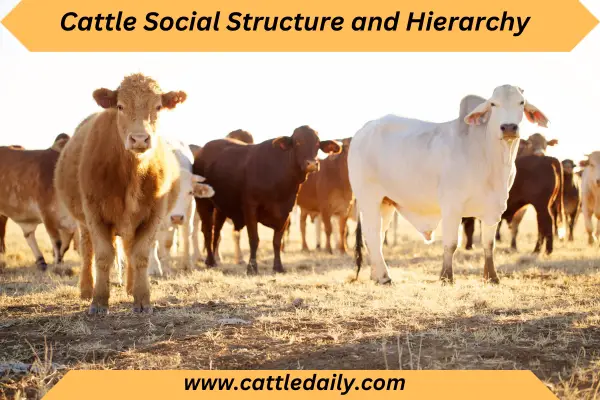
Dominant Behaviors Exhibited by Cattle
Cattle use certain behaviors to assert their dominance within the herd. Here are some of the most common dominant gestures and actions:
1. Head butting and horn threats:
Cattle have horns that serve as weapons and displays of dominance. The lead cow will violently thrust its horns toward subordinate cattle as a show of force.
Quick feints with the horns also act as threats, reminding lower ranks to defer to their authority. Dominant cows angle their horns and shift their head when confronting other cattle, maintaining the ability to inflict serious injury if challenged.
2. Chasing or charging:
Herd hierarchies revolve around priority access to essential resources like food, water, and shade. Dominant cattle reinforce rank by chasing away subordinates from feed, choice grazing spots, drinking water or shaded areas.
The boss cow charges after underlings, using horns, kicks, and body checks to displace lower-ranking herd mates. Chasing establishes the lead cow’s control over resource distribution.
3. Mounting:
Dominant cows and bulls will mount subordinates of both sexes to display social rank in cattle. Mounting among bovines shows the mounter holds a higher status than the mounted animal.
Dominant cattle initiate mounting by chin resting, light biting and chin rubbing. The subordinate animal will stand in place while mounted, signaling acceptance of the dominant’s superior position in the hierarchy.
4. Feeding priority:
The top-ranking cow feeds before all others, claiming the first share of hay, silage, concentrate feeds or pasture. The boss cow consumes their fill, then the next levels in the hierarchy eat in turn.
Subordinate cattle wait to approach food sources until permitted by signals or actions of dominants. Feed priority is one of the clearest signs of an animal’s status within the herd’s stratified social ladder.
5. Aggressive grooming:
Natural grooming behaviors like licking or horning become displays of dominance when initiated forcefully by superior cattle. Dominant cows lick subordinates with strong, rapid tongue movements that cannot be avoided.
Aggressive horning involves rubbing the horns forcefully against underlings, pushing them around and inhibiting their movement. This domineering grooming reinforces ranks and keeps submissives in their place.
6. Confident body language:
Dominant cattle carry themselves with surety and pride due to their elevated herd status. The boss cow struts tall with head held high, moving forcefully through their domain.
Their body blocks access to resources, and subordinates alter their path to move around them. Dominant cattle meet the gaze of herd mates directly and stand their ground in interactions.
7. Vocalizations:
Dominant cattle produce stronger, more frequent vocalizations to cement status. The lead cow’s vocalizations ring out most loudly across pastures. Bulls make loud, bellowing calls in asserting rank.
Dominant cattle grunt, moo, bellow and make unique sounds during interactions with subordinates. Vocal exchanges reinforce social standing.

Signs of Submissive Cattle
Subordinate cattle exhibit clear body language and actions reflecting their lower status. Signs of submissive cattle include:
1. Avoiding eye contact:
Submissive cattle avert their eyes and gaze away when dominant herd members approach or pass nearby. Maintaining eye contact is interpreted as threatening by dominant cattle, so subordinates ensure they look down or away to avoid potential aggression. This deference helps minimize conflict and reinforces status differentials.
2. Low body posture:
Submissive cattle alter their normal posture to appear smaller and non-threatening. Their head and neck lower toward the ground rather than standing tall.
A subordinate’s back may arch slightly downward, minimizing their body size. Ears also flatten backward to avoid appearing dominant. These postures signal acceptance of lower social standing.
3. Allowing displacement:
Subordinate cattle immediately give way to dominants approaching feeding, watering or resting areas. They obediently leave preferred spots upon the arrival of superior herd mates, finding a less ideal location to accommodate the dominant’s priority access. Submissives avoid any behaviors that could be seen as challenging higher-ranked cattle.
4. Licking/sniffing:
Subordinate cattle lick and sniff the face of dominants as gestures of respect and deference. Gentle licks and sniffs of the dominant’s muzzle, chin and nostrils communicate submission.
These affinitive interactions help satisfy dominants and avoid potential aggression toward submissives that overstep boundaries.
5. Waiting to feed:
Subordinates patiently wait behind dominant cattle before approaching food sources. Only upon the lead cow finishing their meal will the next ranking individual advance forward to eat.
Submissive cattle also avoid special treats or desirable feeds until dominants have had their share, even if excess food is available.
6. Avoidance behaviors:
Submissives stay clear of dominants unless necessary, giving them ample space and retreating if approached. A subordinate cow or calf quickly moves away if a dominant walks in their direction. Avoidance reduces the subordinate’s threat potential in the eyes of dominants.
7. Submissive gestures:
Special body language communicates submission, including crouching postures, slow tail wagging, and head tilting. Submissives may also rub or lick dominants. These gestures diffuse tension and signal acceptance of the relationship.
8. Fewer vocalizations:
Subordinates make fewer sounds and vocalize more softly and less frequently than dominants. Their moos, grunts and calls are not attention-seeking. Submissive cattle know their place and avoid excessive noise that may be seen as a challenge to superiors.
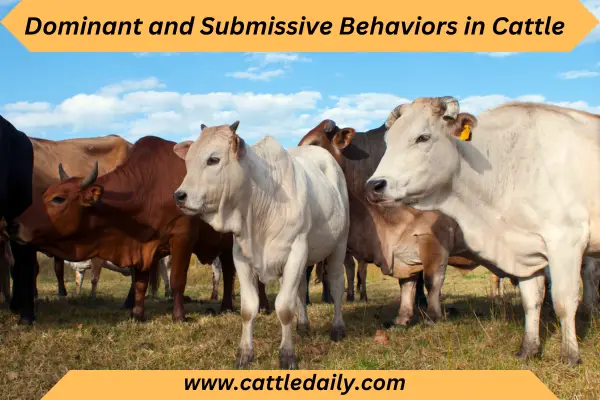
Factors that Influence Dominance in Cattle
- Age: Older cattle often attain the highest ranks in the herd hierarchy. Mature cows have the advantage of size, strength and experience to support dominant roles. The herd matriarch is usually the oldest female bovine.
- Sex: Male cattle tend to dominate females. Intact breeding bulls exert dominance over cows and heifers, using size and strength to their advantage. Castrated steers drop in rank versus females.
- Weight: Heavier, thicker cattle can throw their bulk around more easily in jostling and confrontations. Large body size correlates to higher dominance status in altercations between cattle.
- Horns: Horned cattle have an advantage over polled (hornless) peers in displays of dominance. The presence of horns allows cattle to threaten horn thrusts and cause harm, eliciting submission. Dehorned cattle typically rank lower.
- Breed: Some cattle breeds have notoriously more aggressive dispositions that support dominance behaviors. Breeds like Brahman, Romagnola, and Ankole-Watusi are known to be more assertive and controlling versus milder breeds such as Jersey or Holstein.
In general, the oldest, heaviest, fully intact male bovine with large horns will dominate a cattle herd. However, individual temperament also plays a role separate from physical traits. Knowledge of influential dominance factors allows cattle owners to make informed decisions on herd management.
Tips for Managing Dominant and Submissive Cattle
As a cattle owner, there are steps you can take to manage dominant-submissive dynamics for a healthy, productive herd:
1. Separate overly aggressive dominants:
If a particular boss cow or bull is excessively bullying subordinates, isolate them temporarily or permanently for the safety of other cattle. Provide a separate pen or paddock away from more timid herd mates. This protects less dominant animals from injury or stress.
2. Ensure adequate resources:
Providing ample sources of food, water and shade based on herd size reduces competition that can heighten aggression. Dominant cattle have less need to fight for limited resources or displace others if supplies are bountiful. Space out multiple hay racks, water troughs and shade shelters.
3. Reorganize herd groups:
Periodically shuffling the composition of the herd introduces new dynamics. Old dominants find their authority challenged as hierarchies re-establish, reducing stagnant bullying patterns. Try reordering small cow-calf groups or swapping cows between breeding groups.
4. Cull habitual aggressors:
In some cases, chronically violent cattle may need to be removed permanently for the welfare of the herd. Consistently aggressive cows and bulls that test human handlers should be culled to prevent future injuries or trauma.
5. Add visual barriers:
Physical divisions in feeding areas allow cattle of all ranks uninterrupted access. Solid walls between feed bunks or hay racks prevent bossy animals from monitoring and controlling subordinate’s feed intake.
6. Provide escape areas:
Subordinate cattle can retreat from aggressive dominants if shelters or spaces are accessible. Open sheds, safe zones with gates, or simply scattered brush/trees offer an escape route. Give timid animals the ability to remove themselves from conflict.
7. Distribute resources:
Disperse food, mineral feeders, water stations and shade areas throughout pastures. This spacing reduces crowding and incidents where dominants can control access to limited essentials. Make resources available in multiple sites.
8. Monitor for injuries:
Signs like cuts, limping, swollen areas or missing hair may reflect overly forceful dominants. Try to notice injuries promptly so bullies can be identified and managed. A veterinarian can assess wounds and provide needed treatment.
9. Consult a veterinarian:
Schedule a visit with your cattle vet to discuss concerns over excessive herd aggression. Your vet can help devise strategies to curb bullying and foster healthier interactions between specific cattle. Medications may help in some instances.
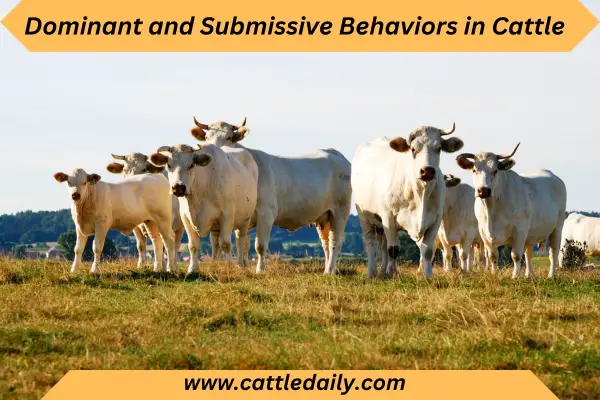
Minimizing Aggression and Fostering Healthy Interactions
While hierarchies are normal in cattle, excessive bullying or violence is problematic. Here are tips for minimizing aggression while encouraging healthy social order:
1. Ensure adequate living space:
Overcrowded conditions lead to heightened friction between cattle as they jostle for finite resources and personal space. Reduce stocking densities or expand living areas to lower tensions.
2. Disrupt mounting behaviors:
If forceful mounting exceeds brief displays of dominance, gently move or separate mounters to minimize stress on repeatedly mounted herd mates.
3. Pet subordinate cattle:
Timid, submissive cows and calves can gain confidence through gentle human touch and interaction. Positive contact helps counter bullying that may occur within the herd.
4. Make quick corrections:
When witnessing forceful acts like head butting or charging, use cues like “hey” or clapping to interrupt the behavior before injury or trauma occurs.
5. Use cow-calming supplements:
Long-acting supplements like tryptophan or CBD oil help take the edge off highly excitable, aggressive cattle when needed. Consult your veterinarian.
6. Add brushes to scratch on:
Placing vertical brushes in pastures or pens satisfies scratching urges and reduces excessive horning behaviors on other cattle.
7. Raise calves together:
Calves raised as contemporaries from a young age establish lifelong bonds and healthy dynamics typically free of unchecked aggression later in life.
8. Add enrichment activities:
Devices like large balls, treat-dispensing puzzle feeders or hanging scrubs offer constructive outlets for natural behaviors. Redirect energy away from subordinates.
9. Consult an animal behaviorist:
For extreme herd aggression issues, enlisting an animal behavior specialist can help identify causes and customize solutions through scientific evaluation.
Conclusion
Cattle naturally form stratified social structures headed by dominant boss cows. Each animal fills a role within the hierarchy that serves to keep order and minimize infighting.
By recognizing normal dominant and submissive cattle behaviors, producers can better manage herds for productivity and welfare. Monitoring for excessive bullying while fostering healthy interactions allows cattle to reap the benefits of herd living. Learn here more about cattle behaviors and their social nature.
